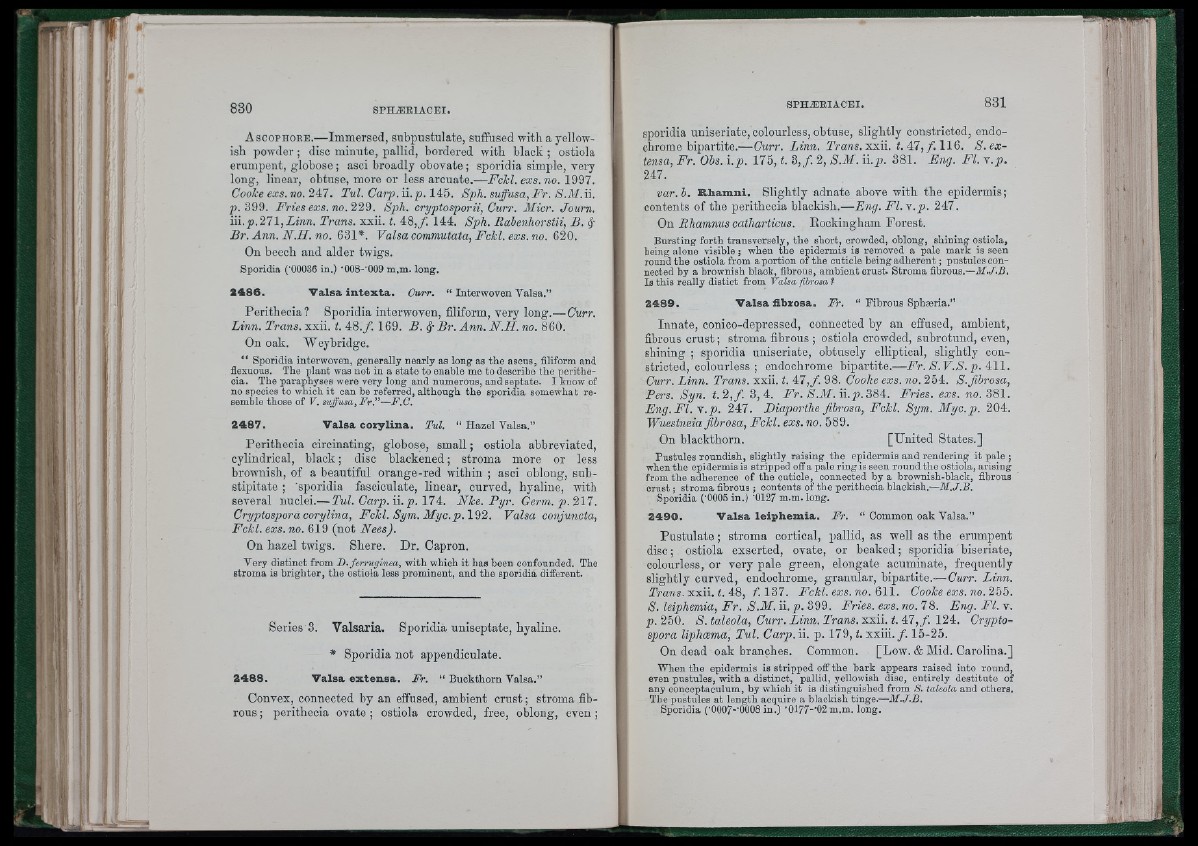
A scop h o r e .— Immersed, subpustulate, suffused with a yellowish
powder ; disc minute, pallid, bordered with black ; ostiola
erumpent, globose ; asci broadly obovate ; sporidia simple, very
long, linear, obtuse, more or less arcuate.—Fchl. exs. no. 1997.
Cooke exs. no. 247. Tul. Carp. ii. p. 145. Sph. suffusa, Fr. S.M. ii.
p. 399. Fries exs. no. 229. Sph. cryptosporii, Curr. Micr. Journ.
Hi. p. 211, Linn. Trans, xxii. t. 4 8 ,/. 144. Sph. Rabenhorstii, B. &
Br. Ann. N.II. no. 631*. Valsa commutata, Fckl. exs. no. 620.
On beech and alder twigs.
Sporidia (’00036 in.) ’008-’009 m.m. long.
2 4 8 6 . V a lsa in t e x t a . Curr. “ Interwoven Valsa.”
Perithecia? Sporidia interwoven, filiform, very long.— Curr.
Linn. Trans, xx ii. t. 4 8 ./. 169. B. & Br. Ann. N.H. no. 860.
On oak. Weybridge.
“ Sporidia interwoven, generally nearly as long as the ascna, filiform and
flexuous. The plant was not in a state to enable me to describe the perithecia.
The paraphyses were very long and numerous, and septate. I know of
no species to which it can be referred, although the sporidia somewhat resemble
those of V. suffusa,Fr.”—F.C.
2 4 8 7 . V a lsa co zyllna . Tul. “ Hazel Valsa.”
Perithecia circinating, globose, small ; ostiola abbreviated,
cylindrical, black ; disc blackened ; stroma more or less
brownish, of a beautiful orange-red within ; asci oblong, substipitate
; 'sporidia fasciculate, linear, curved, hyaline, with
several nuclei.— Tul. Carp.ii. p. 174. Nke. Pyr. Germ. p . 217.
Cryptospora corylina, Fckl. Sym. Myc. p .l9 2 . Valsa conjuncta,
Fckl. exs. no. 619 (not Nees).
On hazel twigs. Shere. Dr. Capron.
Yery distinct from D. ferruginea, witli which it has been confounded. The
stroma is brighter, the ostiola less prominent, and the sporidia different.
Series S. Valsaría. Sporidia uniseptate, hyaline.
* Sporidia not appendiculate.
2 4 8 8 . V a lsa e x te n s a . Fr. “ Buckthorn Valsa.”
Convex, connected by an effused, ambient crust ; stroma fibrous
; perithecia ovate ; ostiola crowded, free, oblong, even ;
sporidia uniseriate, colourless, obtuse, slightly constricted, endochrome
bipartite.—Curr. Linn. Trans, xxii. i.4 7 ,/. 116. S. extensa,
Fr. Obs. i.p. 175, t. 3 ,/. 2, S.M. ii._p. 381. Fng. Fl. Y .p .
247.
var.b. R h am n i. Slightly adnate above with the epidermis;
contents of the perithecia blackish.—Eng. F I.y .p . 247.
On Rhamnus catharticus. Rockingham Forest.
Bursting forth transversely, tbe short, crowded, oblong, shining ostiola,
being alone visible ; when the epidermis is removed a pale mark is seen
round tbe ostiola from a portion of tbe cuticle being adherent; pustules connected
by a brownish black, fibrous, ambient crust. Stroma fibrous.—M.J.B.
Is this really distiet from Valsa fibrosa f
2 4 8 9 . V a lsa fibrosa. Fr. “ Fibrous Sphæria.”
Innate, conico-depressed, connected hy an effused, ambient,
fibrous crust; stroma fibrous ; ostiola crowded, snbrotund, even,
shining ; sporidia uniseriate, obtusely elliptical, slightly constricted,
colourless ; endochrome bipartite.—Fr. S .V .S . p. 411.
Curr. Linn. Trans, xxii. t. 47,/. 98. Cooke exs. no. 254. S.fibrosa,
Pers. Syn. f.2 ,/. 3,4. Fr. S.M. ii.p .384. Fries, exs. wo. 381.
Eng.Fl. Y .p . 247. Diaporthe fibrosa, Fckl. Sym. Myc.p. 204.
Wuestneia fibrosa, Fckl. exs. no. 589.
On blackthorn. [United States.]
Pustules roundish, slightly raising tbe epidermis and rendering it pale ;
when the epidermis is stripped off a pale ring is seen round the ostiola, arising
from the adherence of the cuticle, connected by a brownish-black, fibrous
c ru st; stroma fibrous ; contents of the perithecia blackish.—M.J.B.
Sporidia (’0005 in.) ’0127 m.m. long.
2 4 9 0 . V a lsa le iph em ia . Fr. “ Common oak Valsa.”
Pustulate; stroma cortical, pallid, as well as the erumpent
disc; ostiola exserted, ovate, or beaked; sporidia biseriate,
colourless, or very pale green, elongate acuminate, frequently
slightly curved, endochrome, granular, bipartite.—Curr. Linn.
Trans, xxii. t. 48, f. 137. Fckl. exs. no. 611. Cooke exs. no. 255.
S. leiphemia, Fr. S.M. ii.p . S99. Fries, exs. no. 78. Eng. Fl. v.
p. 250. S. taleola, Curr. Linn. Trans, xxii. t. 47, f . 124. Cryptospora
liphcema, Tul. Carp. ii. p. 179, t. xxiii./. 15-25.
On dead oak branches. Common. [Low. & Mid. Carolina.]
■When the epidermis is stripped off the hark appears raised into round,
even pustules, with a distinct, pallid, yellowish disc, entirely destitute of
any conceptaculum, by which it is distinguished from S. taleola and others.
The pustules at length acquire a blackish tinge.—M.J.B.
Sporidia C0007-’0008 in.) ’0 1 7 7 - '0 2m.m. long.